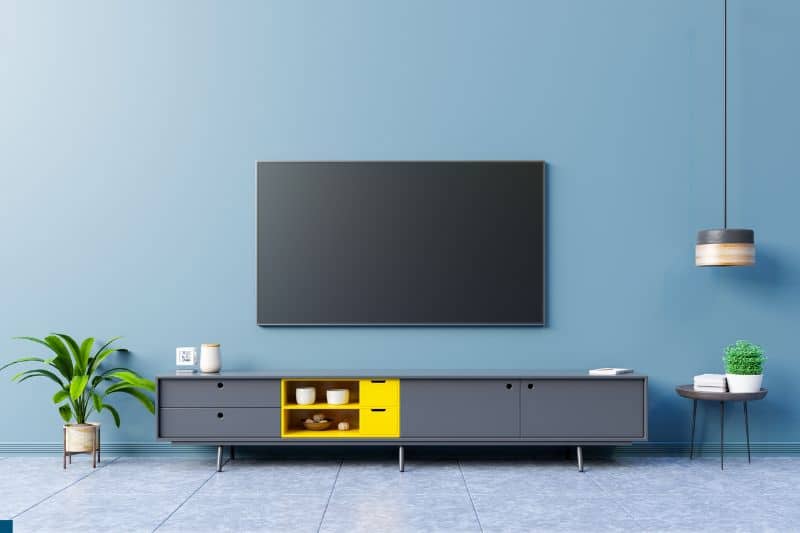When it comes to selecting the perfect TV for your home, a 55-inch model can offer an excellent balance between size and features. You might be wondering about the exact dimensions of a 55-inch TV, so you can ensure it fits comfortably in your living space. In this article, we’ll be discussing the dimensions of 55-inch TVs, and sharing some helpful tips to choose the ideal model for your needs.
The dimensions of a 55-inch TV can vary slightly depending on factors like the screen’s aspect ratio, bezel size, and the design of the TV stand. Generally, the width of a 55-inch TV is approximately 48 inches, while the height is around 28 inches.
However, these measurements might change slightly between different brands and models, so it’s essential to consult the specifications of the TV you’re interested in.
To make an informed decision, it’s crucial to consider not only the size of the TV, but also your room layout, viewing distance, and any additional accessories or features you desire. By considering these factors, you’re sure to find the perfect 55-inch TV that offers the best viewing experience for you and your family.
Read: How Much Does a Generator Weigh?
The dimensions of a 55-inch TV can vary slightly depending on factors like the screen’s aspect ratio, bezel size, and the design of the TV stand. Generally, the width of a 55-inch TV is approximately 48 inches, while the height is around 28 inches.
Measuringly.com
Understanding TV Dimensions
This section explores the important measurements you need to consider when buying a 55-inch TV. We’ll discuss diagonal measurement, width, height, and aspect ratio.
Diagonal Measurement
When you see a TV advertised as 55 inches, the measurement refers to the screen’s diagonal length. This is the distance from one corner of the screen to the opposite corner, usually specified in inches or centimeters.
It’s important to remember that this diagonal measurement doesn’t tell you the width or height, which can vary depending on the TV’s aspect ratio.
Width and Height
To determine the width and height of your 55-inch TV, it’s helpful to know the aspect ratio. The aspect ratio is the proportion of the screen’s width to its height. Most TVs today use a 16:9 aspect ratio, so you can use the formula: width (W) = diagonal (D) × 0.899, and height (H) = diagonal (D) × 0.506.
For a 55-inch TV with a 16:9 aspect ratio, the calculations would be:
- Width: 55 × 0.899 ≈ 49.45 inches
- Height: 55 × 0.506 ≈ 27.83 inches
These approximate dimensions can help you to better plan the placement of your TV in your room.
Aspect Ratio
The aspect ratio of your TV plays a crucial role in determining its dimensions and overall display quality. As mentioned earlier, most modern TVs have a 16:9 aspect ratio, which provides a widescreen format, ideal for movies and high-definition content. Older TVs might have a 4:3 aspect ratio, which gives a more square-shaped display.
Knowing the aspect ratio of your TV can also help you better understand how content will appear on your screen. 16:9 aspect ratio is the standard for most content today, but some movies or older shows might have a different aspect ratio, causing potential letterboxing or pillarboxing.
By understanding diagonal measurements, width and height, and aspect ratio, you can better anticipate how a 55-inch TV will fit within your space and meet your viewing expectations.
55-Inch TV Specifications
Screen Resolution
When selecting a 55-inch TV, you should consider the screen resolution. A higher resolution provides better picture quality. The most common resolutions for 55-inch TVs are:
- Full HD (1080p): This resolution offers 1920×1080 pixels, providing decent picture quality, especially for smaller rooms. Full HD is still widely available and affordable.
- 4K Ultra HD (2160p): A significant step up from Full HD, 4K offers 3840×2160 pixels, delivering four times more detail and clarity. Ideal for larger rooms or if you want a truly immersive experience.
As most content nowadays is available in 4K, opting for a 55-inch TV with 4K resolution is recommended to future-proof your purchase.
TV Types
There are different TV types to choose from, each with its pros and cons. The most common ones are:
- LED (Light Emitting Diode) TVs: These are energy-efficient and come in various sizes, including 55-inch. They are generally more affordable than other types, but may have weaker contrast and color accuracy compared to OLED or QLED TVs.
- OLED (Organic Light Emitting Diode) TVs: Known for their incredible contrast and true blacks, OLED TVs offer a viewing experience like no other. However, they come at a premium price and are less energy-efficient than LED TVs.
- QLED (Quantum Light Emitting Diode) TVs: Samsung’s QLED TVs use quantum dots to improve color accuracy and brightness. They are more affordable than OLED TVs and have better brightness for well-lit rooms. However, the contrast on QLED TVs is slightly inferior to OLED TVs.
To sum up, while shopping for your 55-inch TV, pay attention to the screen resolution and TV type, keeping in mind your budget and room conditions and content availability in your desired resolution.

Mounting and Placement
Wall Mounting Requirements
You’ll need a compatible wall mount to mount your 55-inch TV on the wall. These usually come in three types: fixed, tilt, and full-motion. It’s essential to check the VESA (Video Electronics Standards Association) mounting pattern on your TV. The common VESA pattern for a 55-inch TV is 400x400mm.
- Fixed Mount: This mount keeps your TV fixed in one position, providing a sleek and minimalistic look.
- Tilt Mount: This mount allows you to tilt the TV vertically, which helps reduce glare and provides a better viewing angle from different seating positions.
- Full-motion Mount: This mount gives you the most flexibility with extending, tilting, and swiveling your TV to achieve the optimal viewing experience.
Remember to choose a wall stud to support the weight of your 55-inch TV and follow the specific instructions provided with the mount for a safe installation.
Viewing Distance
The ideal viewing distance for a 55-inch TV can vary depending on the screen resolution. Here’s a brief guideline:
| Screen Resolution | Recommended Viewing Distance |
|---|---|
| HD (720p) | 9 – 12 feet |
| Full HD (1080p) | 7 – 10 feet |
| 4K UHD | 4.5 – 7.5 feet |
Remember that these distances are just recommendations and can vary based on personal preference. Feel free to adjust the placement of your seating area for the most comfortable viewing experience.
TV Size Chart
When considering a 55-inch TV, knowing the dimensions is important to ensure it fits in your desired space. A 55-inch TV typically measures approximately 48.9 inches wide and 27.6 inches high without a stand.
These dimensions are based on the TV’s screen size, measured diagonally from corner to corner. However, since most TVs have a slight bezel or frame around the screen, the overall size might be slightly larger. Remember that the TV’s depth or thickness will vary depending on the model and technology used.
To help you visualize the size of a 55-inch TV in your space, it can be helpful to use painter’s tape or cut a paper template with the dimensions. This lets you easily see if it fits and adjust your furniture layout accordingly.
You should also consider the display resolution – most 55-inch TVs nowadays offer at least 1080p, while 4K resolution TVs are increasingly becoming the standard, providing a crisp, detailed image. Remember that when you’re sitting close to the screen, a higher resolution will provide you with a better viewing experience.
Here’s a simple TV size chart to give you an idea of the width and height of a few different common TV sizes:
| Screen Size (inches) | Width (inches) | Height (inches) |
|---|---|---|
| 32 | 27.9 | 15.7 |
| 40 | 34.9 | 19.6 |
| 50 | 43.6 | 24.5 |
| 55 | 48.9 | 27.6 |
| 65 | 56.7 | 31.9 |
When choosing a 55-inch TV, take your time, and compare the features that matter most to you. Remember to measure your space and ensure the TV you choose fits comfortably in your room. And don’t forget to have fun with your new home entertainment centerpiece!
Read: How Much Does a 5-Gallon Water Jug Weigh?
Will a 55-inch TV Fit in My Car?
Before attempting to transport your new 55-inch TV in your car, it’s crucial to know the dimensions of the TV itself and the available space in your vehicle. Most 55-inch TVs have a width of around 48 inches and a height of about 28 inches. However, these dimensions can vary slightly depending on the brand or model.
To ensure a safe and comfortable fit in your car, begin by measuring the interior space. Start with the trunk, as it’s the most common area used for transporting TVs. If necessary, measure the width, height, and depth with the seats folded down.
If your trunk isn’t large enough, consider utilizing the backseat. Make sure to measure the door opening and the available space inside the car (accounting for any obstructions like car seats). Remember, having a snug fit is essential but still leaves room for padding to protect the screen.
When transporting, always follow these tips to ensure the safety of your TV:
- Lay the TV flat with the screen facing up, avoiding any pressure on the screen.
- Use blankets or padding to protect the TV, especially on the corners.
- Secure the TV with straps or bungee cords to prevent any movement while driving.
- Drive carefully, avoiding any sudden movements that may cause the TV to shift.
Please note that larger cars like SUVs and minivans typically have more space to accommodate a 55-inch TV. If your car is too small, consider asking a friend with a larger vehicle to help or even renting a moving van for the job. Your precious new TV deserves a safe and secure ride to its new home!







